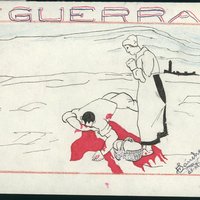
Guerra by Sanchez
The curators would like to acknowledge the following organizations and individuals: University of Chicago Centro Katz, Santander Universidades, Centro de Estudios de Migraciones y Exilios (UNED), Fundación Tomás Segovia, Ateneo Español de México, The Abraham Lincoln Brigade Archives, the de Buen Unna family, Luis Miguel Vargas and Carles Bondia.
The Spanish Civil War was a conflict between the Spanish republican government and military rebels who rose against the elected government with the backing of various right-wing factions and parties including monarchists, fascists, and the Catholic Church. The government had moderate backing from the Soviet Union, Mexico, and international volunteers in the form of the International Brigades, while the rebels were backed by Mussolini’s Italy and Hitler’s Germany.
The Second Spanish Republic was instated after King Alfonso XIII abdicated and left Spain in 1931. The military uprising was the result of growing discontent among formerly privileged classes such as the clergy and the nobility, as well as more extreme conservative factions such as the Falange party, founded by José Antonio Primo de Rivera, which supported the traditional order. As left-wing republican governments pushed for more reforms, the right increasingly appealed to the military to act. Finally several officers, including General Francisco Franco (who eventually became the leader of the rebellion) rose up against the government in July of 1936.
The uprisings started in Morocco and spread to Metropolitan Areas across the country. The war ensued because of the failure of the uprisings across all of Spain. Important regions of the country such as Catalonia and the Basque country supported the government because of the autonomy afforded to them, which would be lost under a right-wing dictatorship. The rebels in those areas were defeated by security forces as well as groups of workers armed by the government. However, in other areas, people who opposed the policies pursued by the Republic joined the rebels. What followed was a conflict that lasted until April 1, 1939.
The war attracted a high level of international attention, with both sides appealing to international support. The rebels received equipment including warplanes and tanks from Italy and Germany, as well as troops. The government tried to get weapons from France and Britain, but only the Soviet Union provided a steady supply of arms, which stopped in 1938. The majority of the international support for the republic came from some 40 000 volunteers from 52 nations across the world, which were collectively known as the International Brigades. This included 2800 American citizens who fought as part of the Abraham Lincoln Brigade.
80 years after the end of the war, this exhibition attempts to showcase some aspects of it. Drawings made by children who were fleeing the conflict, photographs taken in the residences rented to house refugees by the Mexican consulate in Marseilles, personal effects of those displaced, and publications made while in exile are shown. Through this materials we hope to honour those who fought against fascism.
Exhibition curators: Rafael Cruz Gil and Néstor de Buen Alatorre
Acknowledgments: University of Chicago Centro Katz, Santander Universidades, Centro de Estudios de Migraciones y Exilios (UNED), Fundación Tomás Segovia, Ateneo Español de México, The Abraham Lincoln Brigade Archives, the de Buen Unna family, Luis Miguel Vargas and Carles Bondia.